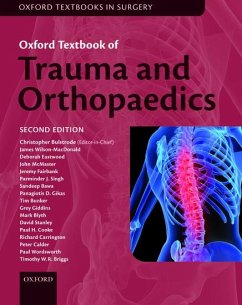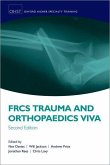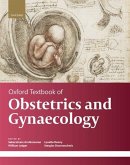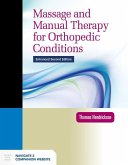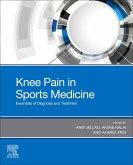Oxford Textbook of Trauma and Orthopaedics
Herausgeber: Bulstrode, Christopher; Bunker, Tim; Gikas, Panagoitis D; Bawa, Sandeep; Singh, Parminder J; Fairbank, Jeremy; McMaster, John; Eastwood, Deborah M; Wilson-Macdonald, James; Stanley, David; Blyth, Mark; Giddins, Grey
Oxford Textbook of Trauma and Orthopaedics
Herausgeber: Bulstrode, Christopher; Bunker, Tim; Gikas, Panagoitis D; Bawa, Sandeep; Singh, Parminder J; Fairbank, Jeremy; McMaster, John; Eastwood, Deborah M; Wilson-Macdonald, James; Stanley, David; Blyth, Mark; Giddins, Grey
- Broschiertes Buch
- Merkliste
- Auf die Merkliste
- Bewerten Bewerten
- Teilen
- Produkt teilen
- Produkterinnerung
- Produkterinnerung
The second edition of this textbook contains all the information needed for a trainee to qualify as a consultant orthopaedic surgeon.
Andere Kunden interessierten sich auch für
![Frcs Trauma and Orthopaedics Viva Frcs Trauma and Orthopaedics Viva]() Nev DaviesFrcs Trauma and Orthopaedics Viva70,99 €
Nev DaviesFrcs Trauma and Orthopaedics Viva70,99 €![Oxford Textbook of Oncology Oxford Textbook of Oncology]() Oxford Textbook of Oncology259,99 €
Oxford Textbook of Oncology259,99 €![Oxford American Handbook of Sports Medicine Oxford American Handbook of Sports Medicine]() Jeffrey BytomskiOxford American Handbook of Sports Medicine89,99 €
Jeffrey BytomskiOxford American Handbook of Sports Medicine89,99 €![Oxford Textbook of Obstetrics and Gynaecology Oxford Textbook of Obstetrics and Gynaecology]() Oxford Textbook of Obstetrics and Gynaecology126,99 €
Oxford Textbook of Obstetrics and Gynaecology126,99 €![Massage and Manual Therapy for Orthopedic Conditions Massage and Manual Therapy for Orthopedic Conditions]() Thomas HendricksonMassage and Manual Therapy for Orthopedic Conditions102,99 €
Thomas HendricksonMassage and Manual Therapy for Orthopedic Conditions102,99 €![The Parents' Guide to Children's Orthopaedics (Russian) The Parents' Guide to Children's Orthopaedics (Russian)]() Ruth FarrellThe Parents' Guide to Children's Orthopaedics (Russian)20,99 €
Ruth FarrellThe Parents' Guide to Children's Orthopaedics (Russian)20,99 €![Knee Pain in Sports Medicine Knee Pain in Sports Medicine]() Anis JelladKnee Pain in Sports Medicine116,99 €
Anis JelladKnee Pain in Sports Medicine116,99 €-
-
-
The second edition of this textbook contains all the information needed for a trainee to qualify as a consultant orthopaedic surgeon.
Hinweis: Dieser Artikel kann nur an eine deutsche Lieferadresse ausgeliefert werden.
Hinweis: Dieser Artikel kann nur an eine deutsche Lieferadresse ausgeliefert werden.
Produktdetails
- Produktdetails
- Verlag: Oxford University Press
- 2nd edition
- Seitenzahl: 1800
- Erscheinungstermin: 2. März 2017
- Englisch
- Abmessung: 272mm x 218mm x 61mm
- Gewicht: 3810g
- ISBN-13: 9780198766506
- ISBN-10: 0198766505
- Artikelnr.: 48500698
- Herstellerkennzeichnung
- Libri GmbH
- Europaallee 1
- 36244 Bad Hersfeld
- gpsr@libri.de
- Verlag: Oxford University Press
- 2nd edition
- Seitenzahl: 1800
- Erscheinungstermin: 2. März 2017
- Englisch
- Abmessung: 272mm x 218mm x 61mm
- Gewicht: 3810g
- ISBN-13: 9780198766506
- ISBN-10: 0198766505
- Artikelnr.: 48500698
- Herstellerkennzeichnung
- Libri GmbH
- Europaallee 1
- 36244 Bad Hersfeld
- gpsr@libri.de
Christopher Bulstrode, Clinical Reader in Trauma and Orthopaedics, University of Oxford, UK, James Wilson-MacDonald, Consultant Orthopaedic and Trauma Surgeon, Nuffield Orthopaedic Centre NHS Trust and Oxford Radcliffe NHS Trust, Oxford, UK, Deborah M. Eastwood, Consultant Paediatric Orthopaedic Surgeon, Royal National Orthopaedic Hospital, Stanmore, Middlesex, UK, John McMaster, Oxford Trauma Unit, John Radcliffe Hospital, Oxford, UK, Jeremy Fairbank, Consultant Orthopaedic Surgeon, St Luke's Hospital, Oxford, UK, Parminder J. Singh, Consultant Orthopaedic and Trauma Surgeon, Maroondah Hospital, Australia, Sandeep Bawa, Department of Rheumatology, Gartnavel General Hospital, Glasgow University Hospitals, Glasgow, UK, Panagoitis D. Gikas, Institute of Orthopaedics and Musculoskeletal Science, Royal National Orthopaedic Hospital, Stanmore, Middlesex, UK, Tim Bunker, Princess Elizabeth Orthopaedic Centre, Royal Devon and Exeter Hospital, Exeter, UK, Grey Giddins, Royal Uni
* Section 1
* 1.1: Foundations of clinical practice
* 1.2: Classification and outcome measures
* 1.3: The musculoskeletal system: structure and function
* 1.4: Injury and repair
* 1.5: Haemoglobinopathies
* 1.6: Prevention of thrombosis in orthopaedic surgery
* 1.7: Pain and its control
* 1.8: Biomechanics
* 1.9: Gait analysis
* 1.10: Imaging
* 1.11: Complex regional pain syndrome
* 1.12: Neuromuscular disorders
* 1.13: Neuromuscular and skeletal manifestations of neurofibromatosis
* Section 2
* 2.1: Choice of surgery for tumour: Staging and surgical margins
* 2.2: Amputations, endoprosthetic joint replacement, massive bone
replacement, other alternatives
* 2.3: Benign tumours of soft tissues
* 2.4: Malignant tumours of soft tissues
* 2.5: Benign bone tumours
* 2.6: Malignant bone tumours
* 2.7: Metastatic bone disease
* Section 3
* 3.1: Cervical spine disorders
* 3.2: Degenerative disease of the thoracic spine
* 3.3: Clinical presentations of the lumbar spine
* 3.4: Non-operative management of non-specific low back pain types 1
and 2
* 3.5: Cauda equina syndrome
* 3.6: Surgical management of chronic low back pain
* 3.7: Management of nerve root pain (syn: sciatica, radicular pain)
* 3.8: Management of neurogenic claudication and spinal stenosis
* 3.9: Clinical presentation of spinal deformities
* 3.10: Idiopathic scoliosis
* 3.11: Congenital scoliosis and kyphosis
* 3.12: Neuromuscular scoliosis
* 3.13: Syndromal scoliosis
* 3.14: Brace treatment in idiopathic scoliosis: the case for treatment
* 3.15: Iatrogenic spinal deformity
* 3.16: Kyphosis
* 3.17: Spondylolisthesis and spondylolysis
* 3.18: The infected spine
* 3.19: Cross-sectional imaging in spinal disorders
* Section 4
* 4.1: The clinical evaluation of the shoulder
* 4.2: Pathology of cuff tears
* 4.3: Treatment of rotator cuff disease
* 4.4: Biceps
* 4.5: Frozen shoulder
* 4.6: Calcifying tendinitis
* 4.7: Instability
* 4.8: Surface replacement of the shoulder
* 4.9: Stemmed total shoulder replacement
* 4.10: Acromioclavicular joint
* 4.11: The clavicle and the sternoclavicular
* 4.12: Disorders of the scapula
* 4.13: Reverse geometry replacement
* Section 5
* 5.1: Clinical evaluation of elective problems in the adult elbow
* 5.2: Lateral and medial epicondylitis
* 5.3: Chronic instability of the elbow
* 5.4: Rheumatoid arthritis of the elbow
* 5.5: Osteoarthritis of the elbow joint
* 5.6: Arthroscopy
* 5.7: Bursitis of the elbow
* Section 6
* 6.1: Assessment and investigation of chronic wrist pain
* 6.2: Degenerative arthritis of the wrist
* 6.3: Kienböck's disease
* 6.4: The distal radioulnar joint
* 6.5: Rheumatoid arthritis of the hand and wrist
* 6.6: Osteoarthritis of the hand
* 6.7: Dupuytren's disease
* 6.8: Tendon disorders
* 6.9: Reconstruction after nerve injury
* 6.10: Peripheral nerve entrapment
* 6.11: Neurophysiological examination of the hand and wrist
* 6.12: Tumours and hand reconstruction
* 6.13: Ganglia of the wrist and hand
* 6.14: Hand infection
* Section 7
* 7.1: Indications for hip replacement
* 7.2: Approaches to the hip
* 7.3: Preoperative planning for total hip replacement, consent, and
complications
* 7.4: Total hip replacement: implant fixation
* 7.5: Implant choice for primary total hip arthroplasty
* 7.6: Bearing surfaces
* 7.7: The young arthritic hip
* 7.8: The complex primary total hip replacement
* 7.9: Surgical options excluding total hip replacement for hip pain
* 7.10: Total hip replacement: modes of failure
* 7.11: Revision total hip replacement and complications in total hip
replacement
* 7.12: Management of total hip replacement periprosthetic fractures
* 7.13: Management of the infected total hip replacement
* 7.14: Hip resurfacing
* 7.15: Sports injuries in the pelvic region
* 7.16: Inflammatory and metabolic bone disorders of the pelvis
* 7.17: Hip pain in the radiologically normal hip
* 7.18: Hip arthroscopy: assessment, investigation, and interventions
* Section 8
* 8.1: History and examination of the knee
* 8.2: Cartilage repair in the young knee
* 8.3: Magnetic resonance imaging of the knee
* 8.4: Osteotomies around the knee
* 8.5: Arthrodesis of the knee
* 8.6: Total knee replacement
* 8.7: Complications of total knee replacement
* 8.8: Revision total knee replacement
* 8.9: Miscellaneous conditions around the knee
* 8.10: The patellofemoral joint
* 8.11: Surgical techniques of anterior cruciate ligament
reconstruction
* 8.12: Combined ligament injuries around the knee
* 8.13: Unicompartmental knee replacement
* 8.14: Meniscal injury and management
* Section 9
* 9.1: Ankle and hindfoot arthritis
* 9.2: Disorders of the forefoot
* 9.3: Diabetic foot
* 9.4: Orthoses of the foot and leg
* 9.5: Tendon and ligament disorders of the foot
* Section 10
* 10.1: Metabolic disease of skeleton and inherited disorders
* 10.2: Rheumatoid arthritis
* 10.3: Crystal arthropathies
* 10.4: Spondyloarthropathies
* 10.5: Inflammatory connective tissue disease
* 10.6: Osteoporosis
* 10.7: Osteoarthritis
* Section 11
* 11.1: Chronic long bone osteomyelitis
* 11.2: Miscellaneous orthopaedic infections
* 11.3: Amputations and prostheses
* 11.4: Acute osteomyelitis
* 11.5: Septic arthritis
* Section 12
* 12.1: Fracture classification
* 12.2: Complications of fractures
* 12.3: Orthopaedic approach to the multiply injured patient
* 12.4: Head, thoracic, and abdominal injury in the orthopaedic patient
* 12.5: Massive transfusion
* 12.6: Blast and ballistic injury
* 12.7: Management of open fractures
* 12.8: Soft tissue coverage
* 12.9: Combined vascular and orthopaedic injuries
* 12.10: Limb salvage versus amputation
* 12.11: Functional bracing
* 12.12: Principles of plate and screw osteosynthesis
* 12.13: Intramedullary nailing
* 12.14: Principles of monolateral external fixation
* 12.15: Principles of circular external fixation in trauma
* 12.16: Absorbable implants for fracture fixation
* 12.17: Stress fractures
* 12.18: Pathological fractures
* 12.19: Management of segmental bone defects
* 12.20: Injuries to muscle-tendon units
* 12.21: Dislocations and joint injuries in the hand
* 12.22: Flexor tendon injuries
* 12.23: Extensor tendon injuries in the hand and wrist
* 12.24: Soft tissue hand injuries
* 12.25: Nerve injuries
* 12.26: Brachial plexus injuries
* 12.27: Replantation
* 12.28: Metacarpal and phalangeal fractures
* 12.29: Scaphoid fractures
* 12.30: Instabilities of the carpus
* 12.31: Injuries to the distal radioulnar joint
* 12.32: Distal radius fracture
* 12.33: Forearm fractures
* 12.34: Elbow fractures and dislocations
* 12.35: Humeral shaft fractures
* 12.36: Fractures and dislocations of the shoulder girdle
* 12.37: Imaging in spinal trauma
* 12.38: Emergency management of the traumatized cervical spine
* 12.39: Upper cervical injuries
* 12.40: Subaxial cervical spine injuries
* 12.41: Whiplash-associated disorders
* 12.42: Thoracic fractures
* 12.43: Thoracolumbar, lumbar, and sacral fractures
* 12.44: Post-traumatic spinal reconstruction
* 12.45: Rehabilitation of spinal cord injuries
* 12.46: Pelvic ring fractures: assessment, associated injuries, and
acute management
* 12.47: Pelvic fracture: definitive management
* 12.48: Fractures of the acetabulum: radiographic assessment and
classification
* 12.49: Management of acetabular fractures
* 12.50: Dislocations of the hip and femoral head fractures
* 12.51: Femoral neck fractures
* 12.52: Trochanteric and subtrochanteric fractures
* 12.53: Femur shaft fractures
* 12.54: Supracondylar fractures of the femur
* 12.55: Patella fractures and dislocations
* 12.56: Tibial plateau fractures
* 12.57: Tibial shaft fractures
* 12.58: Tibial plafond fractures
* 12.59: Ankle fractures
* 12.60: Fractures of the talus and peritalar dislocations
* 12.61: Fractures of the calcaneum
* 12.62: Midfoot and forefoot fractures and dislocations
* Section 13
* 13.1: Osteomyelitis and septic arthritis in children
* 13.2a: Juvenile idiopathic arthritis: medical aspects
* 13.2b: Juvenile idiopathic arthritis: surgical management
* 13.3: An overview of cerebral palsy
* 13.4: Lower limb management in cerebral palsy
* 13.5: Upper limb management in cerebral palsy
* 13.6: Management of the child with total body involvement
* 13.7: The orthopaedic management of myelomeningocoele
* 13.8: Neurological aspects of spinal disorders in children
* 13.9: Arthrogryposis
* 13.10: Common disorders of the lower limb
* 13.11: Congenital upper limb anomalies
* 13.12: Congenital brachial plexus palsy
* 13.13: Malformations of the hand and wrist
* 13.14: Management of the limb deficient child
* 13.15: The management of limb length inequality
* 13.16: Developmental deformities of the lower limbs
* 13.17: Developmental dysplasia of the hip
* 13.18: Legg-Calve-Perthes disease
* 13.19: Slipped capital femoral epiphysis
* 13.20: Common knee conditions
* 13.21: Congenital talipes equinovarus
* 13.22: The foot in childhood
* 13.23: Sports injuries and syndromes
* Section 14
* 14.1: Musculoskeletal injuries in children
* 14.2: Physeal injuries
* 14.3: Fractures of the spine in children
* 14.4: Injuries around the shoulder in children
* 14.5: Fractures about the elbow in children
* 14.6: Fractures and dislocations about the paediatric forearm
* 14.7: Children's hand trauma
* 14.8: Injuries of the pelvis and hip in children
* 14.9: Injuries of the femur and patella in children
* 14.10: Tibial and ankle fractures in children
* 14.11: Foot injuries in children
* 1.1: Foundations of clinical practice
* 1.2: Classification and outcome measures
* 1.3: The musculoskeletal system: structure and function
* 1.4: Injury and repair
* 1.5: Haemoglobinopathies
* 1.6: Prevention of thrombosis in orthopaedic surgery
* 1.7: Pain and its control
* 1.8: Biomechanics
* 1.9: Gait analysis
* 1.10: Imaging
* 1.11: Complex regional pain syndrome
* 1.12: Neuromuscular disorders
* 1.13: Neuromuscular and skeletal manifestations of neurofibromatosis
* Section 2
* 2.1: Choice of surgery for tumour: Staging and surgical margins
* 2.2: Amputations, endoprosthetic joint replacement, massive bone
replacement, other alternatives
* 2.3: Benign tumours of soft tissues
* 2.4: Malignant tumours of soft tissues
* 2.5: Benign bone tumours
* 2.6: Malignant bone tumours
* 2.7: Metastatic bone disease
* Section 3
* 3.1: Cervical spine disorders
* 3.2: Degenerative disease of the thoracic spine
* 3.3: Clinical presentations of the lumbar spine
* 3.4: Non-operative management of non-specific low back pain types 1
and 2
* 3.5: Cauda equina syndrome
* 3.6: Surgical management of chronic low back pain
* 3.7: Management of nerve root pain (syn: sciatica, radicular pain)
* 3.8: Management of neurogenic claudication and spinal stenosis
* 3.9: Clinical presentation of spinal deformities
* 3.10: Idiopathic scoliosis
* 3.11: Congenital scoliosis and kyphosis
* 3.12: Neuromuscular scoliosis
* 3.13: Syndromal scoliosis
* 3.14: Brace treatment in idiopathic scoliosis: the case for treatment
* 3.15: Iatrogenic spinal deformity
* 3.16: Kyphosis
* 3.17: Spondylolisthesis and spondylolysis
* 3.18: The infected spine
* 3.19: Cross-sectional imaging in spinal disorders
* Section 4
* 4.1: The clinical evaluation of the shoulder
* 4.2: Pathology of cuff tears
* 4.3: Treatment of rotator cuff disease
* 4.4: Biceps
* 4.5: Frozen shoulder
* 4.6: Calcifying tendinitis
* 4.7: Instability
* 4.8: Surface replacement of the shoulder
* 4.9: Stemmed total shoulder replacement
* 4.10: Acromioclavicular joint
* 4.11: The clavicle and the sternoclavicular
* 4.12: Disorders of the scapula
* 4.13: Reverse geometry replacement
* Section 5
* 5.1: Clinical evaluation of elective problems in the adult elbow
* 5.2: Lateral and medial epicondylitis
* 5.3: Chronic instability of the elbow
* 5.4: Rheumatoid arthritis of the elbow
* 5.5: Osteoarthritis of the elbow joint
* 5.6: Arthroscopy
* 5.7: Bursitis of the elbow
* Section 6
* 6.1: Assessment and investigation of chronic wrist pain
* 6.2: Degenerative arthritis of the wrist
* 6.3: Kienböck's disease
* 6.4: The distal radioulnar joint
* 6.5: Rheumatoid arthritis of the hand and wrist
* 6.6: Osteoarthritis of the hand
* 6.7: Dupuytren's disease
* 6.8: Tendon disorders
* 6.9: Reconstruction after nerve injury
* 6.10: Peripheral nerve entrapment
* 6.11: Neurophysiological examination of the hand and wrist
* 6.12: Tumours and hand reconstruction
* 6.13: Ganglia of the wrist and hand
* 6.14: Hand infection
* Section 7
* 7.1: Indications for hip replacement
* 7.2: Approaches to the hip
* 7.3: Preoperative planning for total hip replacement, consent, and
complications
* 7.4: Total hip replacement: implant fixation
* 7.5: Implant choice for primary total hip arthroplasty
* 7.6: Bearing surfaces
* 7.7: The young arthritic hip
* 7.8: The complex primary total hip replacement
* 7.9: Surgical options excluding total hip replacement for hip pain
* 7.10: Total hip replacement: modes of failure
* 7.11: Revision total hip replacement and complications in total hip
replacement
* 7.12: Management of total hip replacement periprosthetic fractures
* 7.13: Management of the infected total hip replacement
* 7.14: Hip resurfacing
* 7.15: Sports injuries in the pelvic region
* 7.16: Inflammatory and metabolic bone disorders of the pelvis
* 7.17: Hip pain in the radiologically normal hip
* 7.18: Hip arthroscopy: assessment, investigation, and interventions
* Section 8
* 8.1: History and examination of the knee
* 8.2: Cartilage repair in the young knee
* 8.3: Magnetic resonance imaging of the knee
* 8.4: Osteotomies around the knee
* 8.5: Arthrodesis of the knee
* 8.6: Total knee replacement
* 8.7: Complications of total knee replacement
* 8.8: Revision total knee replacement
* 8.9: Miscellaneous conditions around the knee
* 8.10: The patellofemoral joint
* 8.11: Surgical techniques of anterior cruciate ligament
reconstruction
* 8.12: Combined ligament injuries around the knee
* 8.13: Unicompartmental knee replacement
* 8.14: Meniscal injury and management
* Section 9
* 9.1: Ankle and hindfoot arthritis
* 9.2: Disorders of the forefoot
* 9.3: Diabetic foot
* 9.4: Orthoses of the foot and leg
* 9.5: Tendon and ligament disorders of the foot
* Section 10
* 10.1: Metabolic disease of skeleton and inherited disorders
* 10.2: Rheumatoid arthritis
* 10.3: Crystal arthropathies
* 10.4: Spondyloarthropathies
* 10.5: Inflammatory connective tissue disease
* 10.6: Osteoporosis
* 10.7: Osteoarthritis
* Section 11
* 11.1: Chronic long bone osteomyelitis
* 11.2: Miscellaneous orthopaedic infections
* 11.3: Amputations and prostheses
* 11.4: Acute osteomyelitis
* 11.5: Septic arthritis
* Section 12
* 12.1: Fracture classification
* 12.2: Complications of fractures
* 12.3: Orthopaedic approach to the multiply injured patient
* 12.4: Head, thoracic, and abdominal injury in the orthopaedic patient
* 12.5: Massive transfusion
* 12.6: Blast and ballistic injury
* 12.7: Management of open fractures
* 12.8: Soft tissue coverage
* 12.9: Combined vascular and orthopaedic injuries
* 12.10: Limb salvage versus amputation
* 12.11: Functional bracing
* 12.12: Principles of plate and screw osteosynthesis
* 12.13: Intramedullary nailing
* 12.14: Principles of monolateral external fixation
* 12.15: Principles of circular external fixation in trauma
* 12.16: Absorbable implants for fracture fixation
* 12.17: Stress fractures
* 12.18: Pathological fractures
* 12.19: Management of segmental bone defects
* 12.20: Injuries to muscle-tendon units
* 12.21: Dislocations and joint injuries in the hand
* 12.22: Flexor tendon injuries
* 12.23: Extensor tendon injuries in the hand and wrist
* 12.24: Soft tissue hand injuries
* 12.25: Nerve injuries
* 12.26: Brachial plexus injuries
* 12.27: Replantation
* 12.28: Metacarpal and phalangeal fractures
* 12.29: Scaphoid fractures
* 12.30: Instabilities of the carpus
* 12.31: Injuries to the distal radioulnar joint
* 12.32: Distal radius fracture
* 12.33: Forearm fractures
* 12.34: Elbow fractures and dislocations
* 12.35: Humeral shaft fractures
* 12.36: Fractures and dislocations of the shoulder girdle
* 12.37: Imaging in spinal trauma
* 12.38: Emergency management of the traumatized cervical spine
* 12.39: Upper cervical injuries
* 12.40: Subaxial cervical spine injuries
* 12.41: Whiplash-associated disorders
* 12.42: Thoracic fractures
* 12.43: Thoracolumbar, lumbar, and sacral fractures
* 12.44: Post-traumatic spinal reconstruction
* 12.45: Rehabilitation of spinal cord injuries
* 12.46: Pelvic ring fractures: assessment, associated injuries, and
acute management
* 12.47: Pelvic fracture: definitive management
* 12.48: Fractures of the acetabulum: radiographic assessment and
classification
* 12.49: Management of acetabular fractures
* 12.50: Dislocations of the hip and femoral head fractures
* 12.51: Femoral neck fractures
* 12.52: Trochanteric and subtrochanteric fractures
* 12.53: Femur shaft fractures
* 12.54: Supracondylar fractures of the femur
* 12.55: Patella fractures and dislocations
* 12.56: Tibial plateau fractures
* 12.57: Tibial shaft fractures
* 12.58: Tibial plafond fractures
* 12.59: Ankle fractures
* 12.60: Fractures of the talus and peritalar dislocations
* 12.61: Fractures of the calcaneum
* 12.62: Midfoot and forefoot fractures and dislocations
* Section 13
* 13.1: Osteomyelitis and septic arthritis in children
* 13.2a: Juvenile idiopathic arthritis: medical aspects
* 13.2b: Juvenile idiopathic arthritis: surgical management
* 13.3: An overview of cerebral palsy
* 13.4: Lower limb management in cerebral palsy
* 13.5: Upper limb management in cerebral palsy
* 13.6: Management of the child with total body involvement
* 13.7: The orthopaedic management of myelomeningocoele
* 13.8: Neurological aspects of spinal disorders in children
* 13.9: Arthrogryposis
* 13.10: Common disorders of the lower limb
* 13.11: Congenital upper limb anomalies
* 13.12: Congenital brachial plexus palsy
* 13.13: Malformations of the hand and wrist
* 13.14: Management of the limb deficient child
* 13.15: The management of limb length inequality
* 13.16: Developmental deformities of the lower limbs
* 13.17: Developmental dysplasia of the hip
* 13.18: Legg-Calve-Perthes disease
* 13.19: Slipped capital femoral epiphysis
* 13.20: Common knee conditions
* 13.21: Congenital talipes equinovarus
* 13.22: The foot in childhood
* 13.23: Sports injuries and syndromes
* Section 14
* 14.1: Musculoskeletal injuries in children
* 14.2: Physeal injuries
* 14.3: Fractures of the spine in children
* 14.4: Injuries around the shoulder in children
* 14.5: Fractures about the elbow in children
* 14.6: Fractures and dislocations about the paediatric forearm
* 14.7: Children's hand trauma
* 14.8: Injuries of the pelvis and hip in children
* 14.9: Injuries of the femur and patella in children
* 14.10: Tibial and ankle fractures in children
* 14.11: Foot injuries in children
* Section 1
* 1.1: Foundations of clinical practice
* 1.2: Classification and outcome measures
* 1.3: The musculoskeletal system: structure and function
* 1.4: Injury and repair
* 1.5: Haemoglobinopathies
* 1.6: Prevention of thrombosis in orthopaedic surgery
* 1.7: Pain and its control
* 1.8: Biomechanics
* 1.9: Gait analysis
* 1.10: Imaging
* 1.11: Complex regional pain syndrome
* 1.12: Neuromuscular disorders
* 1.13: Neuromuscular and skeletal manifestations of neurofibromatosis
* Section 2
* 2.1: Choice of surgery for tumour: Staging and surgical margins
* 2.2: Amputations, endoprosthetic joint replacement, massive bone
replacement, other alternatives
* 2.3: Benign tumours of soft tissues
* 2.4: Malignant tumours of soft tissues
* 2.5: Benign bone tumours
* 2.6: Malignant bone tumours
* 2.7: Metastatic bone disease
* Section 3
* 3.1: Cervical spine disorders
* 3.2: Degenerative disease of the thoracic spine
* 3.3: Clinical presentations of the lumbar spine
* 3.4: Non-operative management of non-specific low back pain types 1
and 2
* 3.5: Cauda equina syndrome
* 3.6: Surgical management of chronic low back pain
* 3.7: Management of nerve root pain (syn: sciatica, radicular pain)
* 3.8: Management of neurogenic claudication and spinal stenosis
* 3.9: Clinical presentation of spinal deformities
* 3.10: Idiopathic scoliosis
* 3.11: Congenital scoliosis and kyphosis
* 3.12: Neuromuscular scoliosis
* 3.13: Syndromal scoliosis
* 3.14: Brace treatment in idiopathic scoliosis: the case for treatment
* 3.15: Iatrogenic spinal deformity
* 3.16: Kyphosis
* 3.17: Spondylolisthesis and spondylolysis
* 3.18: The infected spine
* 3.19: Cross-sectional imaging in spinal disorders
* Section 4
* 4.1: The clinical evaluation of the shoulder
* 4.2: Pathology of cuff tears
* 4.3: Treatment of rotator cuff disease
* 4.4: Biceps
* 4.5: Frozen shoulder
* 4.6: Calcifying tendinitis
* 4.7: Instability
* 4.8: Surface replacement of the shoulder
* 4.9: Stemmed total shoulder replacement
* 4.10: Acromioclavicular joint
* 4.11: The clavicle and the sternoclavicular
* 4.12: Disorders of the scapula
* 4.13: Reverse geometry replacement
* Section 5
* 5.1: Clinical evaluation of elective problems in the adult elbow
* 5.2: Lateral and medial epicondylitis
* 5.3: Chronic instability of the elbow
* 5.4: Rheumatoid arthritis of the elbow
* 5.5: Osteoarthritis of the elbow joint
* 5.6: Arthroscopy
* 5.7: Bursitis of the elbow
* Section 6
* 6.1: Assessment and investigation of chronic wrist pain
* 6.2: Degenerative arthritis of the wrist
* 6.3: Kienböck's disease
* 6.4: The distal radioulnar joint
* 6.5: Rheumatoid arthritis of the hand and wrist
* 6.6: Osteoarthritis of the hand
* 6.7: Dupuytren's disease
* 6.8: Tendon disorders
* 6.9: Reconstruction after nerve injury
* 6.10: Peripheral nerve entrapment
* 6.11: Neurophysiological examination of the hand and wrist
* 6.12: Tumours and hand reconstruction
* 6.13: Ganglia of the wrist and hand
* 6.14: Hand infection
* Section 7
* 7.1: Indications for hip replacement
* 7.2: Approaches to the hip
* 7.3: Preoperative planning for total hip replacement, consent, and
complications
* 7.4: Total hip replacement: implant fixation
* 7.5: Implant choice for primary total hip arthroplasty
* 7.6: Bearing surfaces
* 7.7: The young arthritic hip
* 7.8: The complex primary total hip replacement
* 7.9: Surgical options excluding total hip replacement for hip pain
* 7.10: Total hip replacement: modes of failure
* 7.11: Revision total hip replacement and complications in total hip
replacement
* 7.12: Management of total hip replacement periprosthetic fractures
* 7.13: Management of the infected total hip replacement
* 7.14: Hip resurfacing
* 7.15: Sports injuries in the pelvic region
* 7.16: Inflammatory and metabolic bone disorders of the pelvis
* 7.17: Hip pain in the radiologically normal hip
* 7.18: Hip arthroscopy: assessment, investigation, and interventions
* Section 8
* 8.1: History and examination of the knee
* 8.2: Cartilage repair in the young knee
* 8.3: Magnetic resonance imaging of the knee
* 8.4: Osteotomies around the knee
* 8.5: Arthrodesis of the knee
* 8.6: Total knee replacement
* 8.7: Complications of total knee replacement
* 8.8: Revision total knee replacement
* 8.9: Miscellaneous conditions around the knee
* 8.10: The patellofemoral joint
* 8.11: Surgical techniques of anterior cruciate ligament
reconstruction
* 8.12: Combined ligament injuries around the knee
* 8.13: Unicompartmental knee replacement
* 8.14: Meniscal injury and management
* Section 9
* 9.1: Ankle and hindfoot arthritis
* 9.2: Disorders of the forefoot
* 9.3: Diabetic foot
* 9.4: Orthoses of the foot and leg
* 9.5: Tendon and ligament disorders of the foot
* Section 10
* 10.1: Metabolic disease of skeleton and inherited disorders
* 10.2: Rheumatoid arthritis
* 10.3: Crystal arthropathies
* 10.4: Spondyloarthropathies
* 10.5: Inflammatory connective tissue disease
* 10.6: Osteoporosis
* 10.7: Osteoarthritis
* Section 11
* 11.1: Chronic long bone osteomyelitis
* 11.2: Miscellaneous orthopaedic infections
* 11.3: Amputations and prostheses
* 11.4: Acute osteomyelitis
* 11.5: Septic arthritis
* Section 12
* 12.1: Fracture classification
* 12.2: Complications of fractures
* 12.3: Orthopaedic approach to the multiply injured patient
* 12.4: Head, thoracic, and abdominal injury in the orthopaedic patient
* 12.5: Massive transfusion
* 12.6: Blast and ballistic injury
* 12.7: Management of open fractures
* 12.8: Soft tissue coverage
* 12.9: Combined vascular and orthopaedic injuries
* 12.10: Limb salvage versus amputation
* 12.11: Functional bracing
* 12.12: Principles of plate and screw osteosynthesis
* 12.13: Intramedullary nailing
* 12.14: Principles of monolateral external fixation
* 12.15: Principles of circular external fixation in trauma
* 12.16: Absorbable implants for fracture fixation
* 12.17: Stress fractures
* 12.18: Pathological fractures
* 12.19: Management of segmental bone defects
* 12.20: Injuries to muscle-tendon units
* 12.21: Dislocations and joint injuries in the hand
* 12.22: Flexor tendon injuries
* 12.23: Extensor tendon injuries in the hand and wrist
* 12.24: Soft tissue hand injuries
* 12.25: Nerve injuries
* 12.26: Brachial plexus injuries
* 12.27: Replantation
* 12.28: Metacarpal and phalangeal fractures
* 12.29: Scaphoid fractures
* 12.30: Instabilities of the carpus
* 12.31: Injuries to the distal radioulnar joint
* 12.32: Distal radius fracture
* 12.33: Forearm fractures
* 12.34: Elbow fractures and dislocations
* 12.35: Humeral shaft fractures
* 12.36: Fractures and dislocations of the shoulder girdle
* 12.37: Imaging in spinal trauma
* 12.38: Emergency management of the traumatized cervical spine
* 12.39: Upper cervical injuries
* 12.40: Subaxial cervical spine injuries
* 12.41: Whiplash-associated disorders
* 12.42: Thoracic fractures
* 12.43: Thoracolumbar, lumbar, and sacral fractures
* 12.44: Post-traumatic spinal reconstruction
* 12.45: Rehabilitation of spinal cord injuries
* 12.46: Pelvic ring fractures: assessment, associated injuries, and
acute management
* 12.47: Pelvic fracture: definitive management
* 12.48: Fractures of the acetabulum: radiographic assessment and
classification
* 12.49: Management of acetabular fractures
* 12.50: Dislocations of the hip and femoral head fractures
* 12.51: Femoral neck fractures
* 12.52: Trochanteric and subtrochanteric fractures
* 12.53: Femur shaft fractures
* 12.54: Supracondylar fractures of the femur
* 12.55: Patella fractures and dislocations
* 12.56: Tibial plateau fractures
* 12.57: Tibial shaft fractures
* 12.58: Tibial plafond fractures
* 12.59: Ankle fractures
* 12.60: Fractures of the talus and peritalar dislocations
* 12.61: Fractures of the calcaneum
* 12.62: Midfoot and forefoot fractures and dislocations
* Section 13
* 13.1: Osteomyelitis and septic arthritis in children
* 13.2a: Juvenile idiopathic arthritis: medical aspects
* 13.2b: Juvenile idiopathic arthritis: surgical management
* 13.3: An overview of cerebral palsy
* 13.4: Lower limb management in cerebral palsy
* 13.5: Upper limb management in cerebral palsy
* 13.6: Management of the child with total body involvement
* 13.7: The orthopaedic management of myelomeningocoele
* 13.8: Neurological aspects of spinal disorders in children
* 13.9: Arthrogryposis
* 13.10: Common disorders of the lower limb
* 13.11: Congenital upper limb anomalies
* 13.12: Congenital brachial plexus palsy
* 13.13: Malformations of the hand and wrist
* 13.14: Management of the limb deficient child
* 13.15: The management of limb length inequality
* 13.16: Developmental deformities of the lower limbs
* 13.17: Developmental dysplasia of the hip
* 13.18: Legg-Calve-Perthes disease
* 13.19: Slipped capital femoral epiphysis
* 13.20: Common knee conditions
* 13.21: Congenital talipes equinovarus
* 13.22: The foot in childhood
* 13.23: Sports injuries and syndromes
* Section 14
* 14.1: Musculoskeletal injuries in children
* 14.2: Physeal injuries
* 14.3: Fractures of the spine in children
* 14.4: Injuries around the shoulder in children
* 14.5: Fractures about the elbow in children
* 14.6: Fractures and dislocations about the paediatric forearm
* 14.7: Children's hand trauma
* 14.8: Injuries of the pelvis and hip in children
* 14.9: Injuries of the femur and patella in children
* 14.10: Tibial and ankle fractures in children
* 14.11: Foot injuries in children
* 1.1: Foundations of clinical practice
* 1.2: Classification and outcome measures
* 1.3: The musculoskeletal system: structure and function
* 1.4: Injury and repair
* 1.5: Haemoglobinopathies
* 1.6: Prevention of thrombosis in orthopaedic surgery
* 1.7: Pain and its control
* 1.8: Biomechanics
* 1.9: Gait analysis
* 1.10: Imaging
* 1.11: Complex regional pain syndrome
* 1.12: Neuromuscular disorders
* 1.13: Neuromuscular and skeletal manifestations of neurofibromatosis
* Section 2
* 2.1: Choice of surgery for tumour: Staging and surgical margins
* 2.2: Amputations, endoprosthetic joint replacement, massive bone
replacement, other alternatives
* 2.3: Benign tumours of soft tissues
* 2.4: Malignant tumours of soft tissues
* 2.5: Benign bone tumours
* 2.6: Malignant bone tumours
* 2.7: Metastatic bone disease
* Section 3
* 3.1: Cervical spine disorders
* 3.2: Degenerative disease of the thoracic spine
* 3.3: Clinical presentations of the lumbar spine
* 3.4: Non-operative management of non-specific low back pain types 1
and 2
* 3.5: Cauda equina syndrome
* 3.6: Surgical management of chronic low back pain
* 3.7: Management of nerve root pain (syn: sciatica, radicular pain)
* 3.8: Management of neurogenic claudication and spinal stenosis
* 3.9: Clinical presentation of spinal deformities
* 3.10: Idiopathic scoliosis
* 3.11: Congenital scoliosis and kyphosis
* 3.12: Neuromuscular scoliosis
* 3.13: Syndromal scoliosis
* 3.14: Brace treatment in idiopathic scoliosis: the case for treatment
* 3.15: Iatrogenic spinal deformity
* 3.16: Kyphosis
* 3.17: Spondylolisthesis and spondylolysis
* 3.18: The infected spine
* 3.19: Cross-sectional imaging in spinal disorders
* Section 4
* 4.1: The clinical evaluation of the shoulder
* 4.2: Pathology of cuff tears
* 4.3: Treatment of rotator cuff disease
* 4.4: Biceps
* 4.5: Frozen shoulder
* 4.6: Calcifying tendinitis
* 4.7: Instability
* 4.8: Surface replacement of the shoulder
* 4.9: Stemmed total shoulder replacement
* 4.10: Acromioclavicular joint
* 4.11: The clavicle and the sternoclavicular
* 4.12: Disorders of the scapula
* 4.13: Reverse geometry replacement
* Section 5
* 5.1: Clinical evaluation of elective problems in the adult elbow
* 5.2: Lateral and medial epicondylitis
* 5.3: Chronic instability of the elbow
* 5.4: Rheumatoid arthritis of the elbow
* 5.5: Osteoarthritis of the elbow joint
* 5.6: Arthroscopy
* 5.7: Bursitis of the elbow
* Section 6
* 6.1: Assessment and investigation of chronic wrist pain
* 6.2: Degenerative arthritis of the wrist
* 6.3: Kienböck's disease
* 6.4: The distal radioulnar joint
* 6.5: Rheumatoid arthritis of the hand and wrist
* 6.6: Osteoarthritis of the hand
* 6.7: Dupuytren's disease
* 6.8: Tendon disorders
* 6.9: Reconstruction after nerve injury
* 6.10: Peripheral nerve entrapment
* 6.11: Neurophysiological examination of the hand and wrist
* 6.12: Tumours and hand reconstruction
* 6.13: Ganglia of the wrist and hand
* 6.14: Hand infection
* Section 7
* 7.1: Indications for hip replacement
* 7.2: Approaches to the hip
* 7.3: Preoperative planning for total hip replacement, consent, and
complications
* 7.4: Total hip replacement: implant fixation
* 7.5: Implant choice for primary total hip arthroplasty
* 7.6: Bearing surfaces
* 7.7: The young arthritic hip
* 7.8: The complex primary total hip replacement
* 7.9: Surgical options excluding total hip replacement for hip pain
* 7.10: Total hip replacement: modes of failure
* 7.11: Revision total hip replacement and complications in total hip
replacement
* 7.12: Management of total hip replacement periprosthetic fractures
* 7.13: Management of the infected total hip replacement
* 7.14: Hip resurfacing
* 7.15: Sports injuries in the pelvic region
* 7.16: Inflammatory and metabolic bone disorders of the pelvis
* 7.17: Hip pain in the radiologically normal hip
* 7.18: Hip arthroscopy: assessment, investigation, and interventions
* Section 8
* 8.1: History and examination of the knee
* 8.2: Cartilage repair in the young knee
* 8.3: Magnetic resonance imaging of the knee
* 8.4: Osteotomies around the knee
* 8.5: Arthrodesis of the knee
* 8.6: Total knee replacement
* 8.7: Complications of total knee replacement
* 8.8: Revision total knee replacement
* 8.9: Miscellaneous conditions around the knee
* 8.10: The patellofemoral joint
* 8.11: Surgical techniques of anterior cruciate ligament
reconstruction
* 8.12: Combined ligament injuries around the knee
* 8.13: Unicompartmental knee replacement
* 8.14: Meniscal injury and management
* Section 9
* 9.1: Ankle and hindfoot arthritis
* 9.2: Disorders of the forefoot
* 9.3: Diabetic foot
* 9.4: Orthoses of the foot and leg
* 9.5: Tendon and ligament disorders of the foot
* Section 10
* 10.1: Metabolic disease of skeleton and inherited disorders
* 10.2: Rheumatoid arthritis
* 10.3: Crystal arthropathies
* 10.4: Spondyloarthropathies
* 10.5: Inflammatory connective tissue disease
* 10.6: Osteoporosis
* 10.7: Osteoarthritis
* Section 11
* 11.1: Chronic long bone osteomyelitis
* 11.2: Miscellaneous orthopaedic infections
* 11.3: Amputations and prostheses
* 11.4: Acute osteomyelitis
* 11.5: Septic arthritis
* Section 12
* 12.1: Fracture classification
* 12.2: Complications of fractures
* 12.3: Orthopaedic approach to the multiply injured patient
* 12.4: Head, thoracic, and abdominal injury in the orthopaedic patient
* 12.5: Massive transfusion
* 12.6: Blast and ballistic injury
* 12.7: Management of open fractures
* 12.8: Soft tissue coverage
* 12.9: Combined vascular and orthopaedic injuries
* 12.10: Limb salvage versus amputation
* 12.11: Functional bracing
* 12.12: Principles of plate and screw osteosynthesis
* 12.13: Intramedullary nailing
* 12.14: Principles of monolateral external fixation
* 12.15: Principles of circular external fixation in trauma
* 12.16: Absorbable implants for fracture fixation
* 12.17: Stress fractures
* 12.18: Pathological fractures
* 12.19: Management of segmental bone defects
* 12.20: Injuries to muscle-tendon units
* 12.21: Dislocations and joint injuries in the hand
* 12.22: Flexor tendon injuries
* 12.23: Extensor tendon injuries in the hand and wrist
* 12.24: Soft tissue hand injuries
* 12.25: Nerve injuries
* 12.26: Brachial plexus injuries
* 12.27: Replantation
* 12.28: Metacarpal and phalangeal fractures
* 12.29: Scaphoid fractures
* 12.30: Instabilities of the carpus
* 12.31: Injuries to the distal radioulnar joint
* 12.32: Distal radius fracture
* 12.33: Forearm fractures
* 12.34: Elbow fractures and dislocations
* 12.35: Humeral shaft fractures
* 12.36: Fractures and dislocations of the shoulder girdle
* 12.37: Imaging in spinal trauma
* 12.38: Emergency management of the traumatized cervical spine
* 12.39: Upper cervical injuries
* 12.40: Subaxial cervical spine injuries
* 12.41: Whiplash-associated disorders
* 12.42: Thoracic fractures
* 12.43: Thoracolumbar, lumbar, and sacral fractures
* 12.44: Post-traumatic spinal reconstruction
* 12.45: Rehabilitation of spinal cord injuries
* 12.46: Pelvic ring fractures: assessment, associated injuries, and
acute management
* 12.47: Pelvic fracture: definitive management
* 12.48: Fractures of the acetabulum: radiographic assessment and
classification
* 12.49: Management of acetabular fractures
* 12.50: Dislocations of the hip and femoral head fractures
* 12.51: Femoral neck fractures
* 12.52: Trochanteric and subtrochanteric fractures
* 12.53: Femur shaft fractures
* 12.54: Supracondylar fractures of the femur
* 12.55: Patella fractures and dislocations
* 12.56: Tibial plateau fractures
* 12.57: Tibial shaft fractures
* 12.58: Tibial plafond fractures
* 12.59: Ankle fractures
* 12.60: Fractures of the talus and peritalar dislocations
* 12.61: Fractures of the calcaneum
* 12.62: Midfoot and forefoot fractures and dislocations
* Section 13
* 13.1: Osteomyelitis and septic arthritis in children
* 13.2a: Juvenile idiopathic arthritis: medical aspects
* 13.2b: Juvenile idiopathic arthritis: surgical management
* 13.3: An overview of cerebral palsy
* 13.4: Lower limb management in cerebral palsy
* 13.5: Upper limb management in cerebral palsy
* 13.6: Management of the child with total body involvement
* 13.7: The orthopaedic management of myelomeningocoele
* 13.8: Neurological aspects of spinal disorders in children
* 13.9: Arthrogryposis
* 13.10: Common disorders of the lower limb
* 13.11: Congenital upper limb anomalies
* 13.12: Congenital brachial plexus palsy
* 13.13: Malformations of the hand and wrist
* 13.14: Management of the limb deficient child
* 13.15: The management of limb length inequality
* 13.16: Developmental deformities of the lower limbs
* 13.17: Developmental dysplasia of the hip
* 13.18: Legg-Calve-Perthes disease
* 13.19: Slipped capital femoral epiphysis
* 13.20: Common knee conditions
* 13.21: Congenital talipes equinovarus
* 13.22: The foot in childhood
* 13.23: Sports injuries and syndromes
* Section 14
* 14.1: Musculoskeletal injuries in children
* 14.2: Physeal injuries
* 14.3: Fractures of the spine in children
* 14.4: Injuries around the shoulder in children
* 14.5: Fractures about the elbow in children
* 14.6: Fractures and dislocations about the paediatric forearm
* 14.7: Children's hand trauma
* 14.8: Injuries of the pelvis and hip in children
* 14.9: Injuries of the femur and patella in children
* 14.10: Tibial and ankle fractures in children
* 14.11: Foot injuries in children

